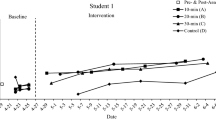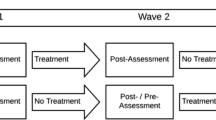Abstract
The taped problems (TP) intervention is a math fact fluency intervention designed to produce high rates of active and accurate academic responding. Multiple single-case design studies have examined the use of TP across grades of students, implementation group sizes, intervention settings, target math facts, total intervention time, application of reinforcement procedures, and inclusion of post-TP exercises as part of the intervention. This meta-analysis examines which TP components are related to greatest increases in math fact fluency. A total of 14 studies with 158 participants were included in the meta-analysis. Results support that TP is an effective intervention to increase math fact fluency, and significant moderators of TP effectiveness include intervention group size, setting, time in seconds in intervention, and the inclusion of reinforcement. Discussion focuses on implications of these findings for research and practice.

Similar content being viewed by others
References
*Denotes article included in meta-analysis
*Aspiranti, K. B., Skinner, C. H., McCleary, D. F., & Cihak, D. F. (2011). Using taped-problems and rewards to increase addition-fact fluency in a first grade general education classroom. Behavior Analysis in Practice, 4, 25–33.
*Bliss, S. L., Skinner, C. H., McCallum, E., Saecker, L. B., Rowland-Bryant, E., & Brown, K. S. (2010). A comparison of taped problems with and without a brief post-treatment assessment on multiplication fluency. Journal of Behavioral Education, 19, 156–168.
Bowman-Perrott, L., Burke, M. D., Zaini, S., Zhang, N., & Vannest, K. (2016). Promoting positive behavior using the Good Behavior Game: a meta-analysis of single-case research. Journal of Positive Behavior Interventions, 18, 180–190.
Bruni, T. P., Drevon, D., Hixon, M., Wyse, R., Corcoran, S., & Fursa, S. (2017). The effect of functional behavior assessment on school-based interventions: a meta-analysis of single-case research. Psychology in the Schools, 54, 351–369.
Burke, M. D., Boon, R. T., Hatton, H., & Bowman-Perrott, L. (2015). Reading interventions for middle and secondary students with emotional and behavioral disorders: a quantitative review of single-case studies. Behavior Modification, 39, 43–68.
Burns, M. K. (2007). Comparison of opportunities to respond within a drill model when rehearsing sight words with a child with mental retardation. School Psychology Quarterly, 22, 250–263.
*Carroll, E., Skinner, C. H., Turner, H., McCallum, E., & Woodland, S. (2006). Evaluating and comparing responsiveness to two interventions designed to enhance math-fact fluency. School Psychology Forum: Research in Practice, 1, 1–18.
Cates, G. L., & Rhymer, K. N. (2003). Examining the relationship between math anxiety and math performance. An instructional hierarchy perspective. Journal of Behavioral Education, 12, 23–34.
Dowker, A. (2005). Early identification and intervention for students with mathematics difficulties. Journal of Learning Disabilities, 38, 324–332.
Drevon, D., Fursa, S. R., & Malcolm, A. L. (2017). Intercoder reliability and validity of WebPlotDigitizer in extracting graphed data. Behavior Modification, 41, 323–339.
Duhon, G. J., Noell, G. H., Witt, J. C., Freeland, J. T., Dufrene, B. A., & Gilbertson, D. N. (2004). Identifying academic skill and performance deficits: the experimental analysis of brief assessments of academic skills. School Psychology Review, 33, 429–443.
Duhon, G. J., House, S., Hastings, K., Poncy, B., & Solomon, B. (2015). Adding immediate feedback to explicit timing: an option for enhancing treatment intensity to improve mathematics fluency. Journal of Behavioral Education, 24, 74–87.
Gagne, R. M. (1982). Some issues in psychology of mathematics instruction. Journal of Research in Mathematics Education, 14, 7–18.
Grafman, J. M., & Cates, G. L. (2010). The differential effects of two self-managed math instruction procedures: cover, copy, and compare versus copy, cover, and compare. Psychology in the Schools, 47, 153–165.
Hasselbring, T. S., Goin, L. I., & Bransford, J. D. (1987). Developing fluency. Teaching Exceptional Children, 1, 30–33.
Haydon, T., Mancil, G. R., & Van Loan, C. (2009). Using opportunities to respond in a general education classroom: a case study. Education and Treatment of Children, 32, 267–278.
Kleinert, W. L., Codding, R. S., Minami, T., & Gould, K. (2017). Meta-analysis of the taped problems intervention. Journal of Behavioral Education, 27, 53–80.
Kratochwill, T. R., Hitchcock, J. H., Horner, R. H., Levin, J. R., Odom, S. L., Rindskopf, D. M., & Shadish, W. R. (2012). Single-case intervention research design standards. Remedial and Special Education, 34, 26–38.
*McCallum, E., & Schmitt, A. J. (2011). The taped problems intervention: increasing the math fact fluency of a student with an intellectual disability. International Journal of Special Education, 26, 276–284.
*McCallum, E., Skinner, C. H., & Hutchins, H. (2004). The taped-problems intervention: increasing division fact fluency using a low-tech self-managed time-delay intervention. Journal of Applied School Psychology, 20, 129–147.
*McCallum, E., Skinner, C. H., Turner, H., & Saecker, L. (2006). The taped-problems intervention: increasing multiplication fact fluency using a low-tech, classwide, time-delay intervention. School Psychology Review, 35, 419–434.
*McCleary, D. F., Aspiranti, K. B., Skinner, C. H., Foster, L. N., Luna, E., Murray, K., …, Woody, A. (2011). Enhancing math-fact fluency via taped problems in intact second- and fourth-grade classrooms. Journal of Evidence-Based Practices for Schools, 12, 179–201.
*Miller, L. C., Skinner, C. H., Gibby, L., Galyon, C. E., & Meadows-Allen, S. (2011). Evaluating generalization of addition-fact fluency using the taped-problems procedure in a second-grade classroom. Journal of Behavioral Education, 20, 203–220.
*Mong, M. D., & Mong, K. W. (2012). The utility of brief experimental analysis and extended intervention analysis in selecting effective mathematics interventions. Journal of Behavioral Education, 21, 99–118.
National Center for Educational Statistics (NCES). (2015). The nation’s report card: math highlights 2015. Washington, DC: U.S. Department of Education.
National Mathematics Advisory Panel (NMAP). (2008). Foundations for success: the final report of the National Mathematics Advisory Panel. Washington, DC: US Department of Education.
OECD. (2016). PISA 2015 results (volume I): excellence and equity in education. Paris: PISA, OECD Publishing.
Parker, R. I., & Vannest, K. (2009). An improved effect size for single-case research: nonoverlap of all pairs. Behavior Therapy, 40, 357–367.
Parker, R. I., Vannest, K. J., Davis, J. L., & Sauber, S. B. (2011). Combining nonoverlap and trend for single-case research: Tau-U. Behavior Therapy, 42, 284–299.
Parker, R. I., Vannest, K. J., & Davis, J. L. (2014). Non-overlap analysis for single case research. In T. R. Kratochwill & J. R. Levin (Eds.), School psychology series. Single-case intervention research: methodological and statistical advances (pp. 127–151). Washington, DC: American Psychological Association.
Parkhurst, J., Skinner, C. H., Yaw, J., Poncy, B., Adcock, W., & Luna, E. (2010). Efficient class-wide remediation: using technology to identify idiosyncratic math facts for additional automaticity drills. International Journal of Behavioral Consultation and Therapy, 6, 111–123.
Pellegrino, J. W., & Goldman, S. R. (1987). Information processing and elementary mathematics. Journal of Learning Disabilities, 20, 23–32.
*Poncy, B. C., Skinner, C. H., & Jaspers, K. E. (2007). Evaluating and comparing interventions designed to enhance math fact accuracy and fluency: cover, copy and compare versus taped problems. Journal of Behavioral Education, 16, 27–37.
*Poncy, B. C., Skinner, C. H., & McCallum, E. (2012). A comparison of class-wide taped problems and Cover, Copy, and Compare for enhancing mathematic fluency. Psychology in the Schools, 49, 744–755.
*Poncy, B. C., Jaspers, K. E., Hansmann, P. R., Bui, L., & Matthew, W. B. (2015). A comparison of taped-problem interventions to increase math fact fluency: does the length of time delay affect student learning rates? Journal of Applied School Psychology, 31, 63–82.
Rohatgi, A. (2015). WebPlotDigitizer (version 4.1) [computer software]. Retrieved from https://automeris.io/WebPlotDigitizer/.
Shapiro, E. S. (2011). Academic skills problems: direct assessment and intervention fourth edition. New York: The Guilford Press.
Sharp, S. R., & Skinner, C. H. (2004). Using interdependent group contingencies with randomly selected criteria and paired reading to enhance class-wide reading performance. Journal of Applied School Psychology, 20, 29–45.
Skinner, C. H. (2002). An empirical analysis of interspersal research: evidence, implications and applications of the discrete task completion hypothesis. Journal of School Psychology, 40, 347–368.
Skinner, C. H., & Smith, E. S. (1992). Issues surrounding the use of self-managed interventions for increasing performance. School Psychology Review, 21, 202–210.
Skinner, C. H., Pappas, D. N., & Davis, K. A. (2005). Enhancing academic engagement: providing opportunities for responding and influencing students to choose to respond. Psychology in the Schools, 42, 389–403.
Sutherland, K. S., Alder, N., & Gunter, P. L. (2003). The effect of varying rates of opportunities to respond to academic requests on the classroom behavior of students with EBD. Journal of Emotional and Behavioral Disorders, 11, 239–248.
VanDerHeyden, A. (2014). Best practices in cant’ do/won’t do assessments. In P. L. Harrison & A. Thomas (Eds.), Best practices in school psychology: data-based and collaborative decision making (6th ed., pp. 305–316). Bethesda: National Association of School Psychologists.
Vannest, K. J., Parker, R. I., & Gonen, O. (2011). Single case research: web based calculators for SCR analysis. (Version 1.0) [web-based application].
*Windingstad, S., Skinner, C. H., Rowland, E., Cardin, E., & Fearrington, J. Y. (2009). Extending research on a math fluency building intervention: applying taped problems in a second-grade classroom. Journal of Applied School Psychology, 25, 364–381.
Wolfe, K., Pyel, D., Charlton, C. T., Sabey, C. V., Lund, E. M., & Ross, S. W. (2016). A systematic review of the empirical support for check-in check-out. Journal of Positive Behavior Interventions, 18, 74–88.
Ysseldyke, J., Thill, T., Pohl, J., & Bolt, D. (2005). Using MathFacts in a flash to enhance computational fluency. Journal of Evidence Based Practices for Schools, 6, 59–89.
Author information
Authors and Affiliations
Corresponding author
Ethics declarations
Ethical Approval
This article does not contain any studies with human participants or animals performed by any of the authors.
Conflict of Interest
Kathleen B. Aspiranti declares that she has no conflict of interest.
Elizabeth McCallum declares that she has no conflict of interest.
Ara J. Schmitt declares that he has no conflict of interest.
Rights and permissions
About this article
Cite this article
Aspiranti, K.B., McCallum, E. & Schmitt, A.J. Taped Problems Intervention Components: A Meta-Analysis. Contemp School Psychol 23, 412–422 (2019). https://doi.org/10.1007/s40688-018-0200-3
Published:
Issue Date:
DOI: https://doi.org/10.1007/s40688-018-0200-3




